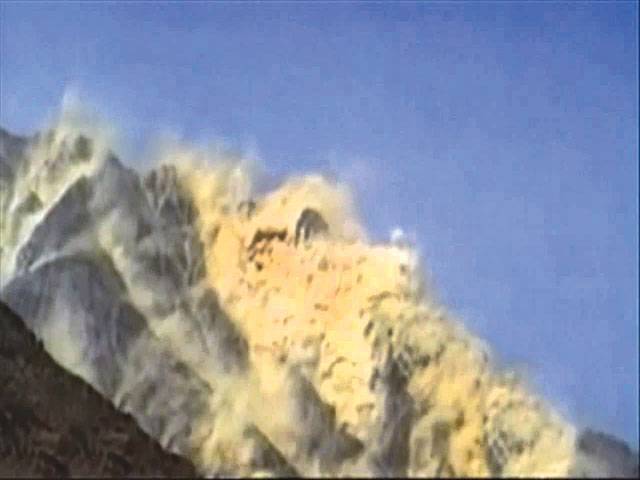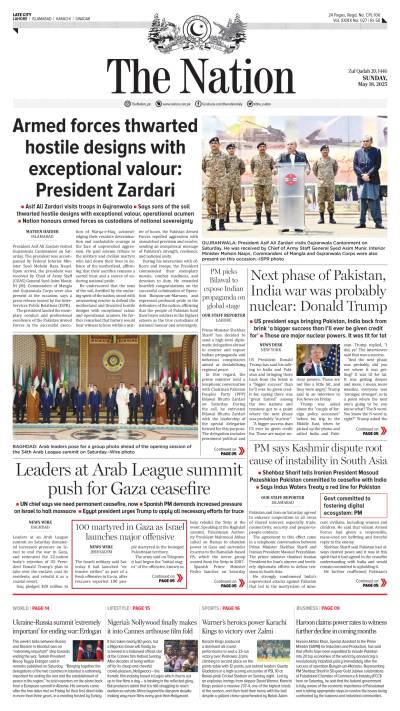ISLAMABAD - When mountains moved and turned pale with the intensity of the shake, Pakistan crossed the nuclear threshold to become a declared nuclear weapons state on May 28, 1998 by detonating five nuclear devices in the Ras Koh Hills in Chagai area of Balochistan province, in response to India’s five tests two weeks earlier.
Pakistan therefore proudly celebrates this day as “Youm-e-Takbir”, which translates as the “Day of Greatness”, to commemorate the country’s achievement. It was the day Pakistan became a member of the elite nuclear powers club – the seventh nation in the world and the first in the Muslim comity to publicly test nuclear weapons.
Shortly before the 1998 tests, the Pakistani government said it had chosen a deserted area in Chagai district to conduct the tests. The blasts took place on a mountain in the Ras Koh range (Koh-E-Kamran), near the village of Chehtar. Pakistan conducted another nuclear test, Chagai-II, two days later on May 30.
The scientists of the Pakistan Atomic Energy Commission (PAEC) chose sites at the high-altitude granite mountain ranges with extremely hot weather. Safety and security required a remote, isolated and unpopulated mountainous area. The Geological Survey of Pakistan conducted tests to select a “bone dry” mountain, capable of withstanding a 20–40 kilo tonne (kt) detonation from inside. The scientists wanted dry weather, and very little wind to avert spread of radioactive fallout.
At Chagai, it was a bright and sunny day without even a single cloud in sight. All personnel, both civil and military, were evacuated from ‘Ground Zero’, except for members of the Diagnostics Group and the firing team. They had been involved in digging out and removing some equipment lying there since 1978.
On “Youm-e-Takbir”, Pakistan became a member of the elite nuclear powers club – the seventh nation in the world and the first in the Muslim comity to publicly test nuclear weapons
For the team in the observational post, the 30 seconds between pushing of the button and the detonations inside the mountain,
were the longest
of their lives
Ten members of the team reached the Observation Post (OP) located 10 kilometres away from Ground Zero. The firing equipment was checked at 1:30pm and prayers were offered. An hour later, at 2:30pm, a Pakistan Army helicopter carrying the team of observers including PAEC Chairman Dr Ishfaq Ahmed, KRL Director Dr AQ Khan and four other scientists from KRL – Dr Fakhr Hashmi, Dr Javed Ashraf Mirza, Dr M Nasim Khan, and S Mansoor Ahmed – arrived at the site. Also accompanying them was a Pakistan Army team headed by General Zulfikar Ali, the chief of the Combat Division.
At 3pm a truck carrying the last of the personnel and soldiers involved in the site preparations passed by the OP. Soon afterward, the all-clear was given to conduct the test as the site had been fully evacuated.
Of the 20 men present, one young man, Muhammad Arshad, the Chief Scientific Officer, who had designed the triggering mechanism, was picked to push the button. He was asked to recite “All praise be to Allah” and push the button. At exactly 3:16pm the button was pressed and Muhammad Arshad stepped from obscurity into history.
The story of Chagai began in 1976 when Brig Muhammad Sarfraz, Chief of Staff at 5 Corps Headquarters, received a transmission from the Pakistan Army General Headquarters (GHQ), Rawalpindi. The message directed the Corps Commander to make available an army helicopter to a forthcoming team of PAEC scientists for operational reconnaissance of some areas in Balochistan. According to the reports, the team comprising Dr Ishfaq Ahmad, Member (Technical), and Dr Ahsan Mubarak landed at Quetta and were provided the helicopter.
Over a span of three days, the scientists made several reconnaissance tours of the area between Turbat, Awaran and Khusdar in the south and Naukundi-Kharan in the east. Their objective was to find a suitable location for an underground nuclear test, preferably a mountain. After a hectic and careful search, they found a mountain which matched their specifications. This was a 185-meter high granite mountain in the Ras Koh Hills in the Chagai Division which at their highest point rise to a height of 3,009 meters.
Ras Koh Hills are independent of and should not be confused with the Chagai Hills further north on the Afghanistan-Pakistan border, in which, to date, no nuclear test activity has taken place. The PAEC requirement was that the mountain should be “bone dry” and capable of withstanding a 20 kilotonne nuclear explosion from inside. Tests were conducted to measure the water content of the mountains and the surrounding area and to measure the capability of the mountain’s rock to withstand a nuclear test. Once this was confirmed, Dr Ishfaq Ahmed commenced work on a three-dimensional survey of the area.
This survey took one year to conduct and, in 1977, it was decided that the proposed tunnel to be bored in the mountain should have the overburden of a 700 metre high mountain over it, making sufficient to withstand 20 kilo-tonnes of nuclear force. Subsequently, the Chagai-Ras Koh-Kharan areas became restricted entry zones and were closed to the public.
Both the nuclear test sites at Ras Koh and Kharan took 2-3 years to prepare and were completed in 1980, before Pakistan acquired the capability to develop a nuclear weapon. This showed both confidence and resolve in Pakistan’s nuclear programme as well as faith in Almighty God.
As soon as the button was pushed, the control system was taken over by the computer. The signal was passed through the airlink initiating six steps in the firing sequence while at the same time bypassing, one after the other, each of the security systems put in place to prevent accidental detonation. Each step was confirmed by the computer, switching on power supplies for each stage. On the last leg of the sequence, the high voltage power supply responsible for detonating the nuclear devices was activated. As the firing sequence passed through each level and shut down the safety switches and activating the power supply, each and every step was being recorded by the computer via the telemetry which is an apparatus for recording reading of an instrument and transmitting them via radio. A radiation-hardened television camera with special lenses recorded the outer surface of the mountain. The voltage reached the triggers on all five devices simultaneously in all the explosive lenses with microsecond synchronization. As the firing sequence continued through its stages, 20 pairs of eyes were glued on the mountain 10 kilometres away. There was deafening silence within and outside of the OP.
A short while after the button was pushed, the earth in and around the Ras Koh Hills trembled. The OP vibrated as smoke and dust burst out through the five points where the nuclear devices were located. The mountain shook and changed colour as the dust of thousands of years was dislodged from its surface. It was black granite rock turning white as de-oxidisation from the radioactive nuclear forces operating from within. A Huge cloud of beige dust then enveloped the mountain.
The time-frame, from the moment when the button was pushed to the moment the detonations inside the mountain took place, was over thirty seconds. For those in the OP, watching in pin-drop silence with their eyes focused on the mountain, those seconds were the longest in their lives. It was the culmination of a journey which started over 20 years ago. It was the moment of truth and triumph against heavy odds, trials and tribulations. At the end of those thirty seconds lay Pakistan’s date with destiny.
After-effects on
Chagai children
The poor locals of Balochistan’s Chagai district view that May 28, 1998 differently as it changed their lives for the worse. According to media reports, they still suffer as a result of the nuclear explosions carried out 21 years ago. The inhabitants in the region are plagued with serious diseases stemming from those blasts. Then Prime Minister Nawaz Sharif had promised to invest in health, education, roads, and infrastructure in the province but the promises are yet to be fulfilled.
Balochistan is the richest of Pakistan’s provinces in terms of natural and mineral resources, and Chagai is one of the richest districts in all of Balochistan. The Reko Diq copper and gold mine there, an untapped resource, is valued at nearly 500 billion dollars. The Sandak Copper-Gold project being run by the Metallurgical Company of China (MCC) is located in Sandak, also in Chagai. And yet, despite the abundance of natural wealth, Balochistan remains the poorest and most backward of the provinces. According to a 2016 UNDP report, 71 percent of the people of Balochistan live in multi-dimensional poverty. The inhabitants of Chagai still yearn for basic amenities: clean drinking water, electricity, hospitals, employment, and academic institutions.
As a result of Pakistan’s nuclear tests in 1998, children are born with genetic problems such as facial deformities, eye problems, skin diseases, and limb dysfunction. The inhabitants put the responsibility on the authorities to mitigate their woes.






